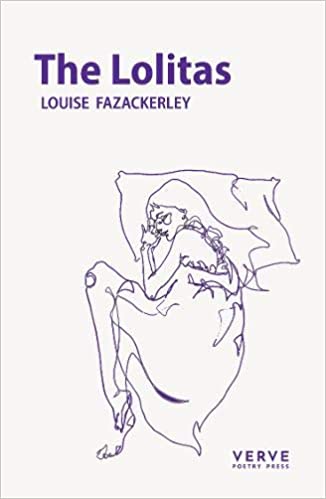REVIEW: LOUISE FAZACKERLEY’S ‘THE LOLITAS’
Reviewed by Stella Backhouse

“I am thinking of aurochs and angels,” declares the paedophile Humbert Humbert in the typically grandiloquent closing passage of Vladimir Nabokov’s scandalous 1955 novel Lolita. “The secret of durable pigments, prophetic sonnets, the refuge of art. And this is the only immortality you and I may share, my Lolita.” The defence of his predatory sexual relationship with a twelve-year-old girl on the grounds of its potential contribution to art, is just one of Humbert Humbert’s many delusions to be picked apart by The Lolitas, Louise Fazackerley’s intensely challenging collection from 2020.
The Lolitas is a complex, multi-dimensional work. Poems about giggly teenage rites-of-passage such as biology lessons and rating boys slide into judgemental adult attitudes to contraception and the ease with which men abuse positions of trust can harness young girls’ fantasies. Punctuating these are claustrophobic narrative fragments in pithy vernacular, centred around a girl called Lola. But this is also a deeply literary collection. As well as Nabokov, it is clearly informed by 1984, the 1949 novel by George Orwell, whose essay/documentary The Road to Wigan Pier takes its name from Fazackerley’s home town. Common to both novels is the use of surveillance. Humbert Humbert spies obsessively on pre-pubescent girls; 1984 is probably still best-known for the phrase ‘Big Brother is watching you’.
Lola inhabits a world adapted for surveillance. The ‘hub and spoke’ structure of her family’s accommodation block recalls the panopticon, defined by Wikipedia as a jail design that allows “all prisoners of an institution to be observed by a single security guard, without the inmates being able to tell whether they are being watched.” She is aware of being watched, but does not know by whom. Instability is conveyed by unpredictably switching narrative voices between Lola, Ma and unnamed others in a single fragment. Who, for example is chronicling that “Lola’s mad coz her Ma asked me to follow her./Slit-eyed I watch her roll out her bed.” Is Ma controlling, or simply concerned? How trustworthy is the person entrusted with following?
But amidst all this looking lurks the suspicion that we are still finding excuses to avoid looking at the right things. Prince Andrew is “the world’s most protected N.O.N.C.E. #metoo”. The so-called ‘Isis bride’ Shamima Begum is caught up in a geopolitical crisis created by others. And while Fazackerley acknowledges the racial origins of the Rotherham child-grooming ring and shares the public outrage it provoked, she points out that “95% of the UK/sex offenders are/white males?”.
In this context, Fazackerley also points the finger at double standards in culture. ‘Serious’ art galleries continue to normalise the sexualisation of children, inviting us to gaze on semi-pornographic works by artists such as Balthus and Egon Shiele. Alice in Wonderland remains a children’s classic, despite speculation having swirled for decades around the precise nature of Lewis Carroll’s friendship with Alice Liddell. A book about the seduction of a twelve year-old is routinely included in lists of Best Novels Of All Time, implying that Lolita’s technical virtuosity trumps its subject matter. But Fazackerley is also aware of the dual nature of sexuality. Lola rationalises that “There’s loads of nudies in art because the human body is gorgeous. You’d be like a sexy Botticelli or summat, if you was in art.”
And indeed, sexuality remains undeniably central to identity. Returning to the personal, the question for mothers of daughters is negotiating how much freedom to give, and when to grant it. The linked poems ‘First/Thirst’ and ‘L is for…’ encapsulate the balancing act. In the first, told from the mother’s point of view, a girl goes on her first date: “In the car on the way to/the pictures/I try to warn her./ Mum, I’m only 12.” In the second, narrated in the second person, the daughter tells Mummy “I’m the L in L.G.B.T.” Mummy’s response is to “feel some hurt./Groom greasy hair…You do not say to her Darling, you’re only 12.”
The difficulty of its source material means The Lolitas will not appeal to everyone. But this is a brave attempt to give credibility to the scary and objectified world of teenage girls, to ask awkward questions and ponder how we oldies can see so much, and at the same time see so little.
Post-script: Among the most embarrassing fates that can befall a reviewer is the realisation, after their review has been published, that they failed to notice something important. When I described The Lolitas’ structure as one of poetry punctuated by “claustrophobic narrative fragments in pithy vernacular, centred around a girl called Lola”, I should have said that this represents poems about real life scenarios interwoven with Lola’s online world of social media and chat rooms – these are the places where she knows she is being watched, but does not know by whom. As the collection’s literary references make clear, predatory paedophiles existed long before the invention of the internet – but the internet has hugely facilitated their activities. Paradoxically, it’s a situation that requires constant vigilance. When Lola meets Humbert in RL, she tells him that she “like[s] how you don’t have screens down here”. Unobserved, she is perhaps at the greatest risk of all.
The Lolitas is available for purchase online from Verve Poetry Press.
